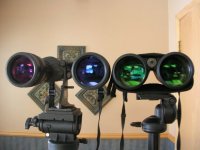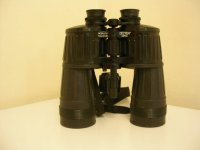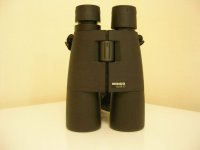Minox 15X58 ED and maybe a Zeiss ?
SD:
You were first with the correct answer to the roof prism model on
the right.
The porro model is the Docter Nobilem 15x60 B/GA. This model shares a lot
with the Zeiss 15x60 BGAT, well recognized as one of the finest 15X
binoculars ever made. Docter Optics were made after WWII in the
Zeiss Jena plant in Eisfeld, Germany, so share much in common.
Holger Merlitz has a nice article about the Docter optics and porro models.
These are still being made and there is now a armor change in the
newest models.
As far as a comparison, they are both very good binoculars, the Minox
BD 15x58 ED BR is heavy with a weight of 1,650 grams with strap and
ocular covers, and the Docter weighs 1,560 grams with an aftermarket
strap and covers.
When comparing the optics the porro design does have some advantages,
as the image appears a bit brighter at low light, and it is a little sharper
than the Minox. The Minox even though it has some ED glass, not sure
about the specs. does show more CA than the Docter.
The Minox does have an easier view and is easier to get behind with its
twist up eyecups, so that is important. The Docter eyecups are the rubber
fold down type, and not as easy for me to use.
Either one can be used handheld, but not for very long as the 15 power
makes them hard to hold steady, so a tripod is the way to go.
I often use mine mounted from my house windows which overlook some farmland
that I scout for wildlife.
These are useful for at least a mile away, for good detail.
Jerry







